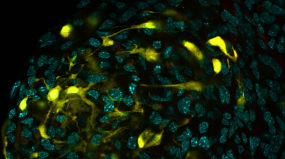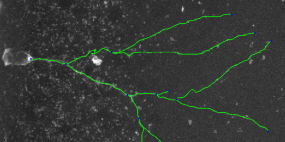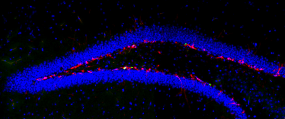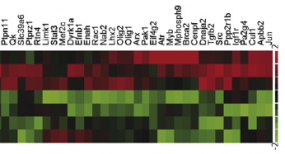Research focus
Stem cells

© dkfz.de
Our lab is interested in the function and regulation of neural stem cells in the developing and adult brain. In the adult brain there are two regions harbouring neural stem/progenitor cells (NPCs) that continuously generate new neurons, the dentate gyrus of the hippocampus (DG) and the subventricular zone of the lateral ventricles (SVZ).Newborn neurons of the hippocampus are involved in learning and memory. Stem cells in the SVZ generate interneurons involved in fine tuning of olfaction. In the diseased brain, NPCs can be activated to repair the brain. Over-activation of these cells can result in tumour formation.
To envisage ways to repair the CNS or block tumor formation the lab studies cell proliferation, and differentiation in the developing and healthy, tumorigenic, and regenerating adult CNS.
Our laboratory has identified CD95 as a receptor signaling survival and neuronal differentiation in the naive and ischemic brain (Corsini et al., Cell Stem Cell 2009).
Axonal regeneration

© dkfz.de
Santiago Ramón y Cajal made several fundamental observations that have defined the perception of axonal regeneration in the central nervous system (CNS) of the past decades. While during development and in the peripheral nervous system, regeneration of nerve fibers does occur, in the adult CNS they do not regenerate. Right after injury, transected axons in the brain and spinal cord extend short distances, but shortly afterwards regeneration is halted and growth cones turn into retraction bulbs (Cajal, 1928). Our laboratory tries to envisage new ways to coax axons towards regeneration using models of crush- and transection-injury of the spinal cord.
Immune system

© dkfz.de
We are interested in the crosstalk between the immune system and the injured CNS with special focus on spinal cord injury and neurodegenerative diseases like Parkinson’s disease. Uncontrolled inflammation drives disease progression, which can result in tissue repair and destruction. Understanding and controlling the damaging inflammatory response are of key importance to tackle disease progression. Since many inflammatory responses are beneficial, directing and instructing the inflammatory response may improve therapeutic strategies. Our lab identified CD95 as a system promoting myeloid cells recruitment to the inflammatory site. Neutralization of CD95L reduced tissue damage after spinal cord injury and improved the locomotor activity of spinal injured animals (Letellier et al., Immunity, 2010).
Signaling

© dkfz.de
CD95 was first described as the inducer of apoptosis and it is still mostly known as the "death receptor". However, research in our group questions this dogma. We showed in several cancer cell lines and primary cell types that CD95 does not act as an apoptosis inducer but rather triggers migration, invasion and differentiation. We have deciphered molecular events originating from CD95 in glioma, neural stem cells and immune cells. Currently, we are investigating corresponding pathways in differentiating neurons and pancreatic cancer. Those findings imply CD95 as a therapeutic target for treating spreading of glioblastoma, neurodegenerative disorders as well as inflammation after spinal cord injury (Kleber et al., Cancer Cell, 2008; Corsini et al., Cell Stem Cell 2009; Sancho Martinez and Martin-Villalba, Cell Cycle, 2009; Letellier et al., Immunity, 2010). Furthermore, by identification of cell-type specific adapters of CD95 signaling we enlarged a potential spectrum of pharmacological intervention.
